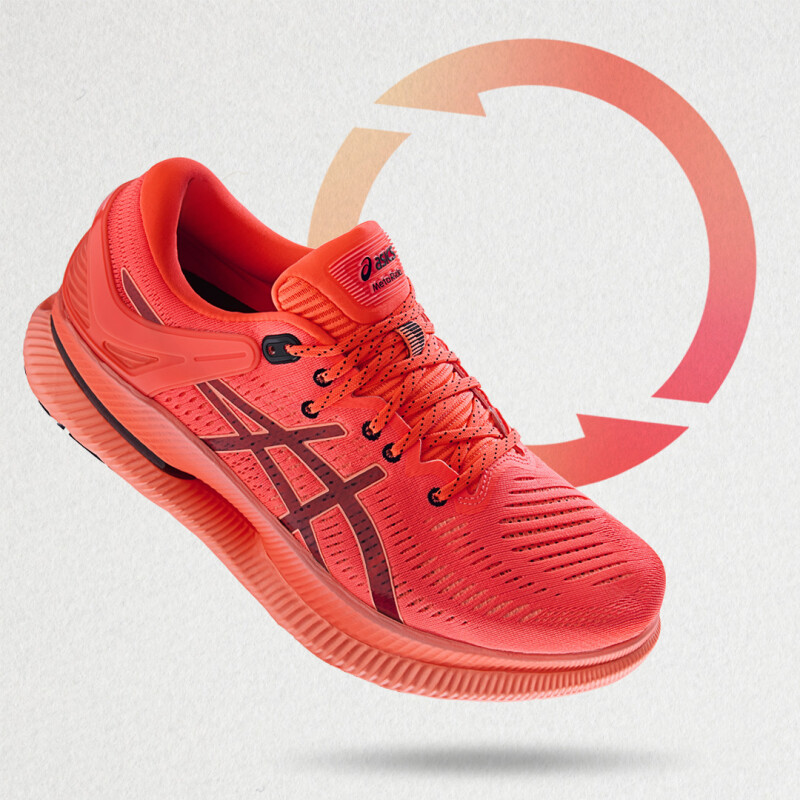Long on the forefront of running industry eco-efforts, ASICS continues to establish aggressive company-wide goals regarding sustainability. Today those initiatives range from reducing emissions to using recycled materials in products as well as packaging.
“Regarding our materials, we’re targeting 100 percent recycled polyester uppers in all footwear by 2030,” says ASICS America merchandising manager Robert Fay. “We are working not only on products such as footwear and apparel, but also on packaging, which is essential for the transportation and protection of merchandise.”
Fay explains that as part of the packaging effort, ASICS reviewed the specifications of its shoebox and introduced an environmentally friendly box last summer.
“The new box is made of 100 percent recycled paper and uses 10 percent less material compared to our previous box,” he explains, while water-based ink rather than oil-based ink saves about 50 percent in ink usage from the original box. The new sustainable version will be applied to an estimated 47.5 million boxes a year and, as a result, ASICS expects to reduce its CO2 emission by approximately 1200 metric tons annually.
Fay also points out that the company has made major sustainability progress across its running and trail lines, with the pinnacle of those efforts the recently released GEL-Nimbus Lite 2 and GEL-Kayano Lite shoes, plus a new trail offering coming in Fall 2021.
“These new models are the sustainable versions of two of our legends models, with over 80 percent recycled polyester in the uppers, a sustainable fiber injected into the midsole to reduce weight without sacrificing durability and a process implemented to reduce waste during the coloration process,” he explains.
ASICS is now launching two unique collections focusing on those sustainability efforts.
¥ The Sunrise Reborn Pack is comprised of two models Ð the Metaride and the GEL-Quantum 360 TYO Ð both of which utilize recycled polyester fabric made from collected clothes in the shoes’ uppers. “We utilize clothing that would be discarded and reduce the usage of virgin polyester raw materials,” says Fay. “We have achieved reducing CO2 emissions by approximately 25 percent in this recycling process, compared to the general manufacturing process of polyester pellets. We are taking up the challenge of circular manufacturing and responding to climate change.”
¥ The second collection is a pack for Earth Day and other similar initiatives are in the pipeline Ñ complete with apparel tie-ins.
Each season, ASICS continues to increase the percentage of items in the line containing sustainable materials, as well as the percentage of sustainable elements in the products, and within the next year expects to release a product with a fully recycled upper. “All new items in the line have 20 percent or more recycled polyester, with the goal of 100 percent by 2030. Each season we’re moving closer and closer to that mark,” according to Fay.
Of course, such advancements also bring unique challenges, primarily sourcing at scale and ensuring the materials and processes adhere to the company’s durability standards.
“We tend to start with tests in a single style, then expand out from there. The team is experimenting with numerous sustainability initiatives per season, all with the goal of broader line adoption going forward,” notes Fay. “Any time you’re trying something new that has not yet been adopted at scale, there can be initial costs associated with R&D and implementation.
“As we implement and expand their presence in our line, those constraints tend to be mitigated,” he adds. “Costing is not the primary challenge, it’s more the scaling up of the programs which plays into some of our targets.”
Addressing consumer demand for sustainable products, Fay believes that some consumers are willing to pay more, but the majority acknowledge that while it is part of their decision matrix, it may not be something they’d pay a premium for currently. As a result, ASICS is focused on offering sustainability as a benefit and giving the consumer the opportunity to decide. For example, the GEL-Nimbus Lite model features more sustainable benefits than the traditional GEL-Nimbus shoe, but both carry the same retail price.
Fay credits run specialty retailers with being a sounding board for the brand through the development process, which has helped lead to initiatives such as the Lite shoes. He adds that while sustainability is a hot topic globally, “we definitely see the U.S. being early adopters in ASICS’ sustainability goals.”






